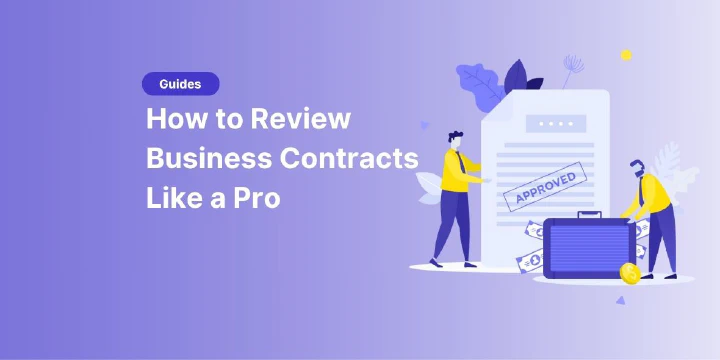15 Types of Contracts and Agreements+Templates
No business runs smoothly without concrete contracts and agreements. No matter how small or big your business is, contracts help you set terms and conditions to protect your interests and ensure a smooth operation. However, with so many different types of contracts out there, it sometimes can be overwhelming to keep track of them all. In this article, we’ll go through 15 common types of contracts and agreements that businesses use. From employment contracts to complex investor agreements, we’ll give you a clear overview of each to help you understand their goal, importance, and key sections. So, let’s dive in!
- 1. Employment Contracts
- 2. Freelancer and Independent Contractor Agreements
- 3. Letter of Intent (LOI)
- 4. Partnership Agreements
- 5. Non-Disclosure Agreements (NDAs)
- 6. Confidentiality Agreements
- 7. Publishing Agreements
- 8. Influencer Agreements
- 9. Business Management Regulation
- 10. Sales Contracts
- 11. Purchase Orders (POs)
- 12. Supply Agreements
- 13. Service Agreements
- 14. Loan Agreements
- 15. Investor Agreements
- How to Manage All Your Business Contracts and Agreements Efficiently?

Here are the most common types of business contracts and agreements:
1. Employment Contracts
- Purpose: Define terms of employment between a company and an employee.
- When to Use: For hiring full-time, part-time, or long-term employees.
A healthy relationship between an employer and employee starts with a strong Employment Contract. This type of company contract sets clear expectations and protects both parties’ interests.
One of the main sections you’ll find in an employment contract is the job title and duties clause which defines what the employee is expected to do on a daily basis. Compensation and the termination of employment clauses are also other important parts that you need to write very carefully.
✨Pro Tip: Always make sure employment contracts comply with labor laws in your country and region. If you’re based in Europe, check out EU directives on working hours, holiday entitlements, and termination procedures.
2. Freelancer and Independent Contractor Agreements
- Purpose: Set terms for hiring freelancers or independent contractors.
- When to Use: For project-specific or temporary work arrangements.
If you have a short-term project in hand and don’t have the human resources, you can always outsource it using a freelance and independent creator agreement. Important clauses in this type of business agreement are the scope of work to prevent extra, unapproved tasks, the payment terms, and the intellectual property ownership to reserve the work you receive from the freelancers.
💡Good to Know: Freelancers usually don’t have the same benefits as regular employees, so having a contract that defines work scope and payment terms is important to avoid confusion.
3. Letter of Intent (LOI)
- Purpose: Outline preliminary terms before signing a detailed agreement.
- When to Use: During the initial stages of a business partnership, acquisition, or major contract.
Need an informal handshake before stepping into a serious agreement? Then, better consider using a Letter of Intent (LOI). In most cases, it’s a non-binding agreement that signals serious interest in entering into a business deal. You can use LOIs for different purposes such as mergers and acquisitions, partnerships, and other important business arrangements.
Typical clauses in an LOI include a non-binding nature, which clarifies which parts of the LOI are not legally binding, and confidentiality. If you don’t like the idea that your future business partner negotiates the same deals with other companies, then, you can add an exclusivity clause. If the exclusivity is partially applied, you can use the exclusions from confidential information clauses to make exceptions.
4. Partnership Agreements
- Purpose: Define terms between business partners sharing ownership.
- When to Use: When forming a partnership or joint venture.
Having multiple shareholders in a company to share ownership, responsibilities, and profits? Then you’ll need a partnership agreement. Of course, a successful partnership is built on trust, but a great partnership agreement guarantees that the boundaries are clearly set and the business will run smoothly.
Here are some key clauses to include in a partnership agreement: Dispute Resolution, which specifies how profits and losses will be shared, the decision-making process, and the exit strategy which gives guidelines for situations when a partner wishes to leave.
🔍 Read more: What’s the difference between a contract and an agreement?
5. Non-Disclosure Agreements (NDAs)
- Purpose: Protect sensitive information shared between parties.
- When to Use: Before sharing confidential information for business purposes.
Found in a wide range of business relationships, NDAs help companies protect trade secrets, proprietary data, and other confidential information from being exposed to unauthorized eyes. There are different types of NDAs with different purposes but the most popular ones are:
- Unilateral NDA
- Mutual NDA
- Employee NDA
- Non-Disclosure Agreement for Contractors
- Non-Disclosure Agreement for Intellectual Property
Common clauses you’ll find in a standard NDA are the definition of confidential information, which shows exactly what information is covered by the agreement, the duration of confidentiality, and of course the consequences of breach clause.
📌Remember: NDA and Confidentiality Agreements are different things: An NDA prevents sharing sensitive information in business contexts, while a confidentiality agreement is broader and can apply to various situations, including internal policies or legal matters.
💡Good to Know: You can even use NDAs in job interviews to make sure that candidates don’t share company plans, products, or strategies with other companies.
6. Confidentiality Agreements
- Purpose: Similar to NDAs, they ensure sensitive information stays private.
- When to Use: When disclosing sensitive information to employees, contractors, or partners.
Much like NDAs, a confidentiality agreement helps companies keep sensitive information safe between parties. They’re common in all sorts of situations, from onboarding new employees to mergers.
A few key parts of a confidentiality agreement are: the scope of confidentiality and permitted disclosures—which list any exceptions, such as legal obligations to share info. Finally, remedies for breach spell out what happens if someone breaks the agreement and how the counterparty can seek damages or take legal action.
🧠Did you Know? Confidentiality agreements often last even after the business relationship ends. So, even if an employee has left a company, he/she might still be obliged to the agreement.
7. Publishing Agreements
- Purpose: Outline terms between authors and publishers.
- When to Use: For publishing books, articles, or other written works.
Publishing agreements define rules of the relationship between a creator—usually an author, or a songwriter—and a publisher. This business contract explains how the publisher will distribute, edit, promote, and sell the creator’s work. In this agreement, the key clauses are grant of rights (details on publisher’s rights), royalties, and payment terms.
✨Pro Tip: When drafting publishing agreements, include a “termination for convenience” clause, especially if you’re dealing with digital content.
8. Influencer Agreements
- Purpose: Set terms between brands and influencers.
- When to Use: When engaging influencers for promotions or collaborations.
This example of business agreement has become more and more popular with outrage on social media. If you run a digital marketing campaign and want to collaborate with social media creators, always use an Influencer contract or a brand ambassador agreement—in case of a long-term relationship.
Don’t forget to add these clauses in your influencer contracts: content requirements (post types, counts, and hashtags), payment and compensation (fees, commissions, or product exchanges), and exclusivity, if you don’t want your partner to work with other brands promoting the same products.
❗Important: Pay attention to FTC or local advertising laws that require clear disclosures when an influencer is paid to promote a product—failing to do so could lead to regulatory fines or legal consequences.
9. Business Management Regulation
- Purpose: Establish rules for company management and operations.
- When to Use: For setting up governance in companies with multiple directors.
Not all business agreements are between the company and an external party. The Business Management Regulation is one example of these contract types. It’s a practical guide that lays out how a company’s management team makes decisions and operates day-to-day.
When creating a Business Management Regulation, you should include sections and guidelines for the decision-making process, compliance with law clauses, and reporting obligations.
❗Important: While often seen as a guide for how management should operate, a Business Management Regulation can also include emergency procedures for crisis management, like what happens if a key executive suddenly leaves.
Sign
any
Document in Less than
a Minute.

10. Sales Contracts
- Purpose: Set terms for selling goods or services to customers.
- When to Use: When offering products or services for a set price.
Sales contracts are straightforward agreements between a seller and buyer that set the terms for exchanging goods or services for money. Key sections include product description and warranty, billing and payment terms (upfront, installments, etc.), and limitation of liability.
🧠Did you Know? Some sales contracts include clauses for customer behavior, like ensuring they don’t resell the product at a lower price, which could hurt the company’s brand or market positioning.
11. Purchase Orders (POs)
- Purpose: Document orders for goods or services.
- When to Use: When purchasing goods or services from suppliers.
Purchase orders (POs) are requests from buyers to suppliers for goods or services. This type of business agreement helps parties to create a clear arrangement before delivery or billing. A standard PO has the following clauses:
Key parts of a PO include a clear order description, deliverables and delivery method, and payment terms.
✨Pro Tip: For international purchases, make sure to include terms related to customs duties and taxes to avoid unexpected costs that could affect your budget.
12. Supply Agreements
- Purpose: Outline terms between suppliers and buyers for ongoing supply.
- When to Use: For regular supply arrangements with a vendor.
Supply agreements are among long-term contract types between suppliers and businesses and they make it easy for parties to keep a steady flow of goods or services. Since they are often long-term, these contracts reduce supply disruptions and also help businesses when budgeting and planning.
Quantity and delivery schedules, quality assurance, and termination clauses are among the common topics in this type of business contract.
❗Important: Supply agreements often include a “force majeure” clause, which allows suppliers to break or delay agreements in cases of unforeseeable events like natural disasters—something not always known to buyers.
13. Service Agreements
- Purpose: Set terms for services provided by a vendor or contractor.
- When to Use: When outsourcing services, like IT support or cleaning.
Service agreements explain the basics of how a service provider will perform for a business. Details like what needs to be done, when, and for how much. They’re great for keeping everyone on the same page, whether it’s for IT support, cleaning, or legal help.
Key parts of a service agreement include the scope of services, payment terms, and confidentiality clause to keep any sensitive business info they come across under wraps.
✨Pro Tip: Always include a clear dispute resolution mechanism (such as arbitration or mediation) in service agreements, particularly in service industries that rely heavily on ongoing performance metrics, to avoid protracted legal conflicts.
14. Loan Agreements
- Purpose: Document terms for lending and borrowing money.
- When to Use: For personal or business loans.
This company contract type covers the terms of a loan between a borrower and a lender. In a loan agreement, details like interest rates, repayment plans, and what happens if payments aren’t made are covered. The goal of this agreement is to protect the lender in case of non-payment and give the borrower a clear picture of what they’re stepping into.
There are many different types of loan agreements, including:
- Business Loan Agreement
- Secured Loan Agreement
- Unsecured Loan Agreement
- Term Loan Agreement
- Revolving Loan Agreement
- Demand Loan Agreement
- Bridge Loan Agreement
- Convertible Loan Agreement
💡Good to Know: The lender can adjust interest rates based on market conditions if Loan agreements have certain clauses. As a result, there may be an unexpected increase in the borrower’s payment amounts.
15. Investor Agreements
- Purpose: Define terms between investors and the business they’re funding.
- When to Use: When investors contribute capital to a business.
If you’re an investor or have a potential investor for your business, you need to draw up this type of contracts. Investor Agreements clearly define how an investor funds a business, which is often in exchange for equity or a share of profits. Important parts of an investor agreement include equity ownership, exit strategy, and profit-sharing.
🧠Did you Know? Investor agreements may include drag-along rights, which force minority investors to sell their shares if a majority shareholder decides to sell the business, sometimes without the minority investor’s consent.
How to Manage All Your Business Contracts and Agreements Efficiently?
With fynk all-in-one digital contract management, you can make the whole process of managing all types of business contracts much easier. fynk helps you keep everything organized with features like automated workflows, version control, and secure document storage and sharing. You can track deadlines, get notification updates, and collaborate effortlessly with your team. Powered by AI, the fynk review feature makes it simple to stay compliant and ensure your contracts are always in check.
Sign
any
Document in Less than
a Minute.

Please keep in mind that none of the content on our blog should be considered legal advice. We understand the complexities and nuances of legal matters, and as much as we strive to ensure our information is accurate and useful, it cannot replace the personalized advice of a qualified legal professional.
Table of contents
- 1. Employment Contracts
- 2. Freelancer and Independent Contractor Agreements
- 3. Letter of Intent (LOI)
- 4. Partnership Agreements
- 5. Non-Disclosure Agreements (NDAs)
- 6. Confidentiality Agreements
- 7. Publishing Agreements
- 8. Influencer Agreements
- 9. Business Management Regulation
- 10. Sales Contracts
- 11. Purchase Orders (POs)
- 12. Supply Agreements
- 13. Service Agreements
- 14. Loan Agreements
- 15. Investor Agreements
- How to Manage All Your Business Contracts and Agreements Efficiently?
Want product news and updates? Sign up for our newsletter.
Other posts in Contract-Management

SaaS contract management explained for buyers and vendors
If you work in SaaS, you know how quickly contracts can pile up. Each one comes with its own terms, renewals, …

The Complete Guide to Effective Contract Repository Management
A contract repository is where every agreement your business depends on finally finds its place. No cluttered …

How to Review Business Contracts Like a Pro in 2025
When it comes to business contracts, what you don’t catch can hurt you. That’s why reviewing a business …
Contracts can be enjoyable. Get started with fynk today.
Companies using fynk's contract management software get work done faster than ever before. Ready to give valuable time back to your team?
Schedule demo







